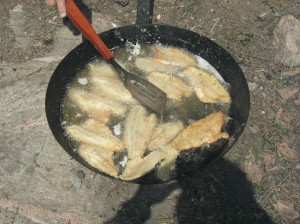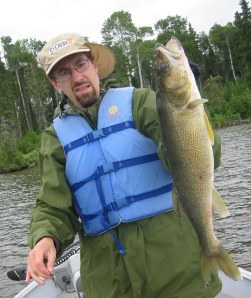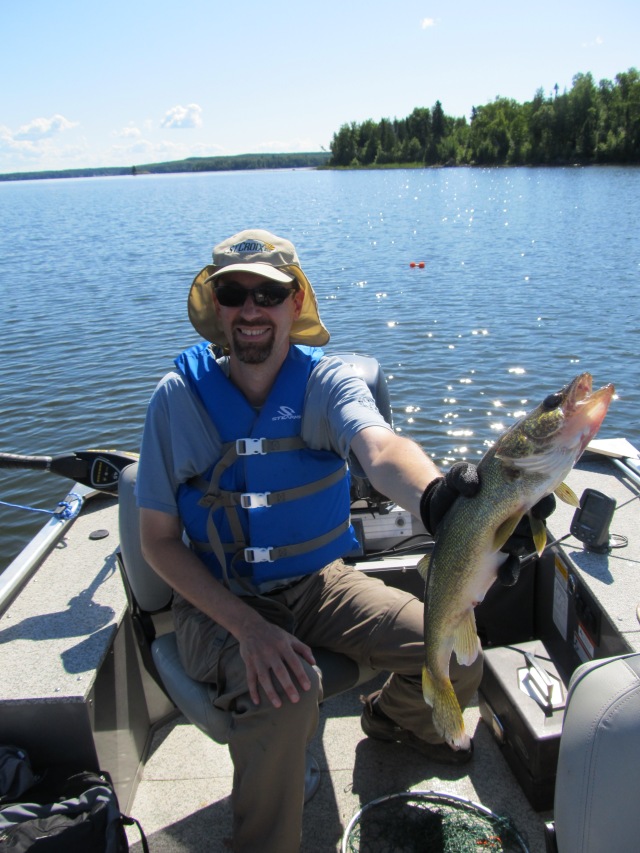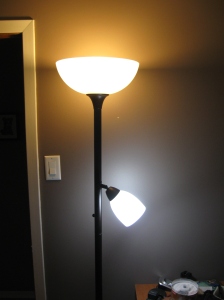We recent ly returned from our fifth annual fishing trip at Clark’s Camp on the Indian Lake Chain just north of Vermilion Bay, Ontario. We spend mornings and evenings in a boat on the lakes catching fish, and afternoons relaxing in camp. We eat fish for supper almost night, and bring lots home to eat through the winter.
ly returned from our fifth annual fishing trip at Clark’s Camp on the Indian Lake Chain just north of Vermilion Bay, Ontario. We spend mornings and evenings in a boat on the lakes catching fish, and afternoons relaxing in camp. We eat fish for supper almost night, and bring lots home to eat through the winter.
Regular readers of this blog may remember that the chain of events that led to my concern about climate change started with a book called “ The Algal Bowl”. That book examined the problem of algal blooms and their causes in lots of different types of waters. Some of the experiments described were conducted (and continue to be conducted) in the Experimental Lakes region of Ontario, located between Vermilion Bay and Kenora. (We actually drive by the access road on our way to and from fishing every year.) One of the causes of algal blooms in lakes like the ones we fish is the depletion of predatory fish due to over-fishing.
The Algal Bowl”. That book examined the problem of algal blooms and their causes in lots of different types of waters. Some of the experiments described were conducted (and continue to be conducted) in the Experimental Lakes region of Ontario, located between Vermilion Bay and Kenora. (We actually drive by the access road on our way to and from fishing every year.) One of the causes of algal blooms in lakes like the ones we fish is the depletion of predatory fish due to over-fishing.
When I was growing up in Thunder Bay in the 70’s and 80’s we had a similar fishing tradition at a location north of Ignace. Over the years, we watched as the size and number of fish we caught declined steadily from the constant fishing pressure there. Every year we go to Clark’s and I see the number of boats on the lake and the number of fish brought ashore and I worry about the same thing happening to the Indian Lakes. Last year we also saw a significant algal bloom in the lake while we were there. Not only does a large raft of algal slime reduce enjoyment of the beach, but if it is extensive it can result in a massive die-off of fish, as the algal growth depletes the available oxygen in the water. Global warming plays a part in this drama too. Warm water holds less dissolved oxygen than cold water, reducing the ability of fish to grow and reproduce. Algae also grows faster in warm water (this is why a hot tub needs more chlorine than a cold swimming pool). According to the lodge staff, the water temperatures this summer were the warmest that they could remember.
Warm water often makes for poor fishing, but we were fortunate this year to have some of the best fishing we’ve ever had there. At one point in the middle of the week we all had at our limits, and found ourselves releasing fish of a size that we would normally consider ourselves fortunate to catch. This made me think about the health of the fish that we were releasing.
I have gotten better at quickly getting a fish off the hook, taking a picture, and releasing it back into the water, and the fish I release usually seem quite healthy as they dive back to the bottom of the lake. Sometimes though, a fish will get hooked in an awkward way, which makes removing the hook without seriously injuring the fish difficult or impossible. This is sometimes because of the barb on the hook. Many jurisdictions, including Manitoba, require all fishing to be done with barbless hooks, to reduce injuries to released fish. Ontario encourages but does not mandate the use of barbless hooks. The disadvantage of going barbless is that more fish will get off the hook on the way up to the boat. However, when you are just catching and releasing, I think using barbless hooks is the responsible thing to do.
Barbless hooks seem to be difficult to find, but regular hooks can be made barbless simply by crimping the barb against the shaft of the hook with a pair of plyers. Next year I plan to do at least some of my fishing with barbless hooks, and I will encourage my companions to do the same.
The other action that recreational fishermen can take to encourage the continued health of fish populations is to be selective about the sizes of fish that they keep. When I was growing up, we always kept the largest fish that we could, the rationale being that smaller fish needed to be left in the lake to grow larger so we could keep catching big fish. Now we realized that it is important to leave the largest fish in the lake, since the largest fish lay the most eggs, and are the fish that need to be there to keep the fish population healthy. Ontario fishing regulations limit each person to one pickerel over 18 inches. The Clarks know that their business depends on t here being lots of fish in the lakes for their guests to catch, and so they strongly encourage the release of all pickerel over 22 inches, and they sweeten the pot by allowing everyone who does to enter a draw for a free vacation the following year. I had the good fortune to enter the draw 3 years ago after catching and releasing a 25 incher. A 13 inch walleye will produce about 3,000 eggs in a breeding season, while a 22 inch fish will produce over 100,000. It is important to leave these large breeding fish in the lake, and it is also important to allow some of the smaller fish to grow large enough to replace the breeding fish, which are not productive forever. It takes a female walleye about 6 years to reach 22 inchese in length.
here being lots of fish in the lakes for their guests to catch, and so they strongly encourage the release of all pickerel over 22 inches, and they sweeten the pot by allowing everyone who does to enter a draw for a free vacation the following year. I had the good fortune to enter the draw 3 years ago after catching and releasing a 25 incher. A 13 inch walleye will produce about 3,000 eggs in a breeding season, while a 22 inch fish will produce over 100,000. It is important to leave these large breeding fish in the lake, and it is also important to allow some of the smaller fish to grow large enough to replace the breeding fish, which are not productive forever. It takes a female walleye about 6 years to reach 22 inchese in length.
I hope to be able to go back to Clark’s year after year, and continue to catch fish like this decades from now.


